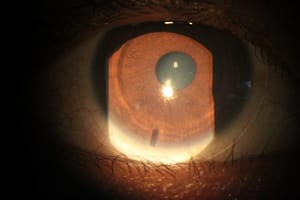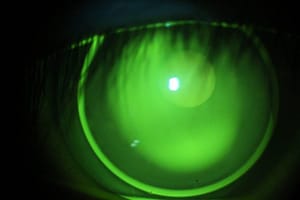
So we know that the corneas of keratoconus become thinner and irregular in shape. The cornea becomes steeper or more curved. How does this relate to vision? When light hits the irregularly thin cornea, light scatters and does not focus correctly on the retina. Irregular astigmatism and nearsightedness make vision blurry. People with keratoconus often cannot see distant things clearly and need to move their mobile phones or computers just a couple of inches away from their noses.
For mild stages, eyeglasses or conventional soft contact lenses may suffice. However, adding the prescription will not improve your vision for moderate to severe cases. This is where specialty contact lenses come in.
In today’s article, we will be discussing the pros and cons of the following specialty lenses: customized soft lenses for keratoconus, small GP lenses (RGP), and scleral lenses.
Customized Soft Lenses for Keratoconus

Unlike the simple, off-the-shelf contact lenses fitted for standard eye grade, this type of customized soft contact lens is made with a thicker material that can hide some of your irregular astigmatism. However, because it is still a soft lens, the amount of astigmatism that it can mask is still limited. In addition, for stability, this is slightly larger than regular soft contact lenses.
Pros
Easy to handle
Convenient
Comfortable on eye
Cons
Not for advanced stages of keratoconus.
Vision may not be as clear as gas permeable or scleral lenses.
Need to be replaced frequently (every 3 to 4 months)
Cost more
Small GP Contact Lens (RGP)

GPs are hard lenses made from oxygen-permeable materials. The size can be 7.5mm to 11.2mm in diameter. Because it is made with a rigid material, it provides a smooth surface to allow the light to enter the eye and forms a more focused image. This helps immensely in allowing you to see clearer. Small GPs may be fitted with a soft lens underneath to improve the fit or comfort. This combination is called piggyback system.
Pros
Provides good vision clarity
It can last longer depending on the stability of the condition
Convenient
Cheaper
Cons
Not comfortable for some, requires an adaptation period
May displace on eye
Not suitable for severe cases
Scleral Contact Lens
On the other hand, scleral lenses are also made from a gas permeable material but bigger than conventional GPs. A scleral lens may be as small as 14.5 to as large as 24mm. Like GPs, this lens acts as an artificial surface to allow the light to enter smoothly and focus better on the retina. So vision becomes more precise. However, it is different from a small GP lens in its fitting. Scleral lens vaults the entire cornea, which means there is a sizeable distance from the back part of the lens to the corneal surface. This liquid-filled space allows the scleral lens to be fitted in even the most severe cases. Also, due to its size, the eyelids do not have constant interaction with the lens edge, so it is more comfortable than a GP.
Pros
Comfortable
Provides good clarity and more stable vision
Can be fitted with reading grade for those 40 years old and above
Suitable for mild to severe cases
Can last longer
Helps in dry eye patients
Cons
Learning curve in handling
Cost more
About the Doctor:
 Dr. Millette Romualdez is a Fellow of the American Academy of Optometry, Scleral Lens Society, Philippine College of Optometry and International Association of Contact Lens Educators. She has also received a Certification of Advanced Contact Lenses from the Australian College of Optometry.
Dr. Millette Romualdez is a Fellow of the American Academy of Optometry, Scleral Lens Society, Philippine College of Optometry and International Association of Contact Lens Educators. She has also received a Certification of Advanced Contact Lenses from the Australian College of Optometry.
To book an appointment for a doctor that fits keratoconus contact lenses such as scleral contact lenses, GP lenses and Kerasoft IC , contact us via 09215452389 or docmillette@goldheartoptical.com.









